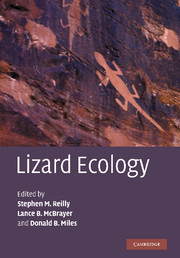Book contents
- Frontmatter
- Contents
- List of contributors
- Preface
- Historical introduction: on widely foraging for Kalahari lizards
- I Organismal patterns of variation with foraging mode
- II Environmental influences on foraging mode
- 12 The foraging biology of the Gekkota: life in the middle
- 13 Foraging mode in the African cordylids and plasticity of foraging behavior in Platysaurus broadleyi
- 14 Interactions between habitat use, behavior, and the trophic niche of lacertid lizards
- 15 Food acquisition modes and habitat use in lizards: questions from an integrative perspective
- 16 The evolution of foraging behavior in the Galápagos marine iguana: natural and sexual selection on body size drives ecological, morphological, and behavioral specialization
- 17 The evolution of the foraging mode paradigm in lizard ecology
- Index
- References
16 - The evolution of foraging behavior in the Galápagos marine iguana: natural and sexual selection on body size drives ecological, morphological, and behavioral specialization
Published online by Cambridge University Press: 04 August 2010
- Frontmatter
- Contents
- List of contributors
- Preface
- Historical introduction: on widely foraging for Kalahari lizards
- I Organismal patterns of variation with foraging mode
- II Environmental influences on foraging mode
- 12 The foraging biology of the Gekkota: life in the middle
- 13 Foraging mode in the African cordylids and plasticity of foraging behavior in Platysaurus broadleyi
- 14 Interactions between habitat use, behavior, and the trophic niche of lacertid lizards
- 15 Food acquisition modes and habitat use in lizards: questions from an integrative perspective
- 16 The evolution of foraging behavior in the Galápagos marine iguana: natural and sexual selection on body size drives ecological, morphological, and behavioral specialization
- 17 The evolution of the foraging mode paradigm in lizard ecology
- Index
- References
Summary
Introduction
Each year thousands of tourists visit the Galápagos Islands and become intrigued by the unique habits of the world's only sea-going lizard, the Galápagos marine iguana (Amblyrhynchus cristatus), as it swims offshore and dives under the waves to feed. One of the islands' first visitors, Charles Darwin, reported fascination with watching these creatures forage, and he
opened the stomach of several, and in each case found it largely distended with minced sea-weed … [that] grows at the bottom of the sea, at some little distance from the coast.
(Darwin, 1839)We now know that the Galápagos marine iguana is the only terrestrial vertebrate that forages almost exclusively on macrophytic marine algae. Although marine iguanas are active foragers, their short, intense bouts of foraging activity more closely resemble the activity pattern of sit-and-wait foragers. To understand why these endemic lizards have adapted such a unique foraging strategy and how it differs from the general pattern of foraging in lizards, we must examine the social and environmental selective pressures that are unique to this species and its environment.
The Galápagos marine iguana is a model system to understand how natural and sexual selection drive morphological and behavioral adaptations. In this chapter we will show how the unique foraging strategy of the marine iguana is an adaptation resulting from the forces of both sexual selection, acting through their unique social system, and natural selection by a harsh and variable environment.
- Type
- Chapter
- Information
- Lizard Ecology , pp. 491 - 507Publisher: Cambridge University PressPrint publication year: 2007
References
- 7
- Cited by



